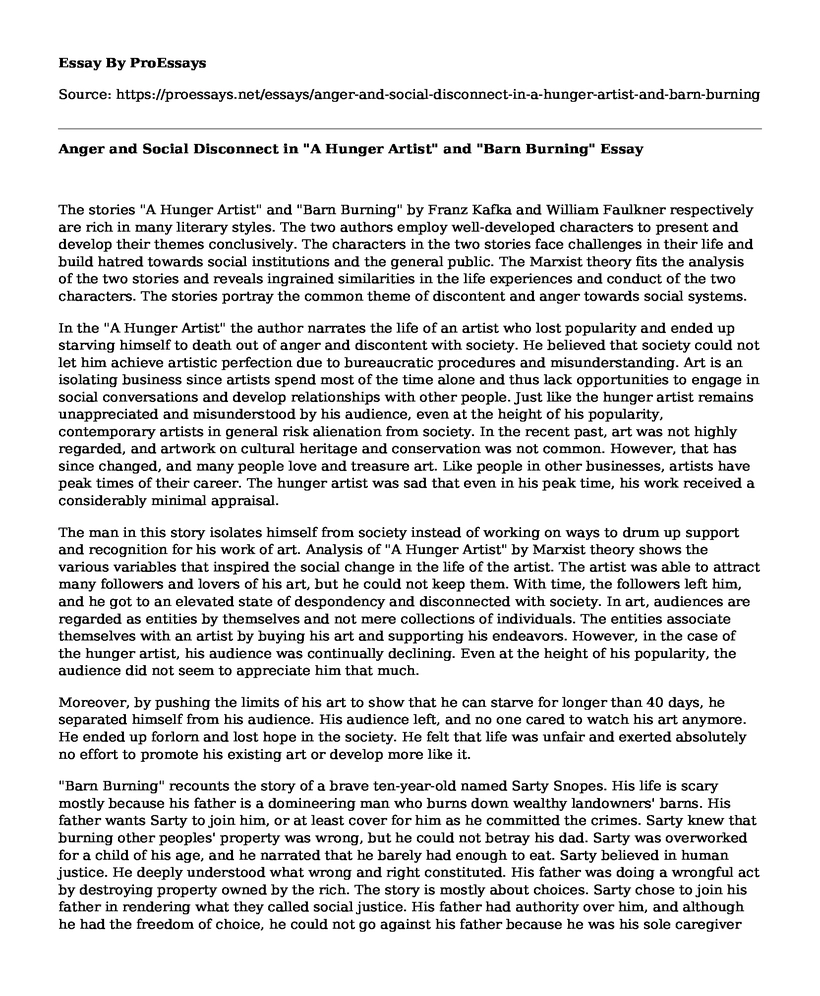The stories "A Hunger Artist" and "Barn Burning" by Franz Kafka and William Faulkner respectively are rich in many literary styles. The two authors employ well-developed characters to present and develop their themes conclusively. The characters in the two stories face challenges in their life and build hatred towards social institutions and the general public. The Marxist theory fits the analysis of the two stories and reveals ingrained similarities in the life experiences and conduct of the two characters. The stories portray the common theme of discontent and anger towards social systems.
In the "A Hunger Artist" the author narrates the life of an artist who lost popularity and ended up starving himself to death out of anger and discontent with society. He believed that society could not let him achieve artistic perfection due to bureaucratic procedures and misunderstanding. Art is an isolating business since artists spend most of the time alone and thus lack opportunities to engage in social conversations and develop relationships with other people. Just like the hunger artist remains unappreciated and misunderstood by his audience, even at the height of his popularity, contemporary artists in general risk alienation from society. In the recent past, art was not highly regarded, and artwork on cultural heritage and conservation was not common. However, that has since changed, and many people love and treasure art. Like people in other businesses, artists have peak times of their career. The hunger artist was sad that even in his peak time, his work received a considerably minimal appraisal.
The man in this story isolates himself from society instead of working on ways to drum up support and recognition for his work of art. Analysis of "A Hunger Artist" by Marxist theory shows the various variables that inspired the social change in the life of the artist. The artist was able to attract many followers and lovers of his art, but he could not keep them. With time, the followers left him, and he got to an elevated state of despondency and disconnected with society. In art, audiences are regarded as entities by themselves and not mere collections of individuals. The entities associate themselves with an artist by buying his art and supporting his endeavors. However, in the case of the hunger artist, his audience was continually declining. Even at the height of his popularity, the audience did not seem to appreciate him that much.
Moreover, by pushing the limits of his art to show that he can starve for longer than 40 days, he separated himself from his audience. His audience left, and no one cared to watch his art anymore. He ended up forlorn and lost hope in the society. He felt that life was unfair and exerted absolutely no effort to promote his existing art or develop more like it.
"Barn Burning" recounts the story of a brave ten-year-old named Sarty Snopes. His life is scary mostly because his father is a domineering man who burns down wealthy landowners' barns. His father wants Sarty to join him, or at least cover for him as he committed the crimes. Sarty knew that burning other peoples' property was wrong, but he could not betray his dad. Sarty was overworked for a child of his age, and he narrated that he barely had enough to eat. Sarty believed in human justice. He deeply understood what wrong and right constituted. His father was doing a wrongful act by destroying property owned by the rich. The story is mostly about choices. Sarty chose to join his father in rendering what they called social justice. His father had authority over him, and although he had the freedom of choice, he could not go against his father because he was his sole caregiver and provider for his basic needs.
The Marxist theory gives a general orientation to analyze the situations in the story's society and understand the reasons for the actions perpetrated by Sarty and his father. The people lived in two broad economic classes. The rich were wealthy and owned large burns to store their produce and equipment. The extremely poor class to which Sarty and his family belong presents a clear contrast to the privileged class of their wealthy landlord. While Sarty's father was engaged in personal class wars against all those wealthier than him, he pushed his family further into poverty. As his father moved further away from society Sarty was drawn closer to it and felt the urge to be of benefit and contribute to ending the mess of poverty.
Conclusion
The hunger artist and Sarty's father were discounted with society and were angry for what their lives had turned to. They experienced intense social changes that altered their worldview altogether. Society is not always fair, and sometimes good people bear the brunt of the injustices. However, people should never lose hope and should pursue social change as presented by the Marxist theory.
Cite this page
Anger and Social Disconnect in "A Hunger Artist" and "Barn Burning". (2022, Aug 15). Retrieved from https://proessays.net/essays/anger-and-social-disconnect-in-a-hunger-artist-and-barn-burning
If you are the original author of this essay and no longer wish to have it published on the ProEssays website, please click below to request its removal:
- Was Creon Right in Condemning Antigone? Essay Example
- The Significance of the Title 'Fences' Essay
- Important Aspects of Othello's Character - Essay Sample
- Compare and Contrast Essay on Translation of the Opening Lines of the Odyssey
- Poetry Analysis Essay on Love Is a Two-Way Street: Exploring Its Metaphorical Meaning
- Essay Example on Eugenie Grandet and Hero of Our Time
- Book Review Example on The Hot House Life Inside Leavenworth Prison







